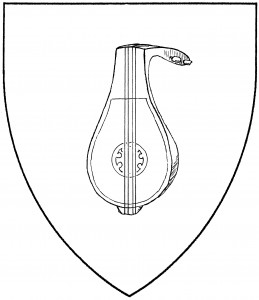A gittern is a stringed musical instrument, found from the end of the 13th Century until supplanted by the Renaissance guitar. There has been a great deal of confusion about the gittern: the name has been wrongly used to describe other instruments (e.g., the citole), and the gittern itself has been called other names (e.g., a mandora). Such agreement as we can find among modern musicologists makes the gittern a smaller version of the round-backed lute, with the entire instrument, body and neck, carved from a single piece of wood. The gittern had four strings (or courses of strings), and was played with a plectrum. The illustration is taken from the figure in Amiens Cathedral, 1375 [Grove 9:907].
Very similar to the gittern, and adding to the confusion, was the 16th Century “cittern”: a descendant of the citole, it had a flat back (unlike the gittern’s rounded back) and a somewhat longer, fretted neck. Like the gittern, it had four courses of strings, and was played with a plectrum [Grove 5:877].
Both the gittern and the cittern have the same default orientation in Society heraldry: affronty, with strings facing the viewer, and with neck to chief. See also viol.
Thomas of St. John bears as a badge: Argent, a gittern bendwise sinister sable.
Margaret Katheryn Cameron bears: Ermine, in saltire a short sword and a cittern proper, overall a rosebud Or, stalked and leaved vert.
